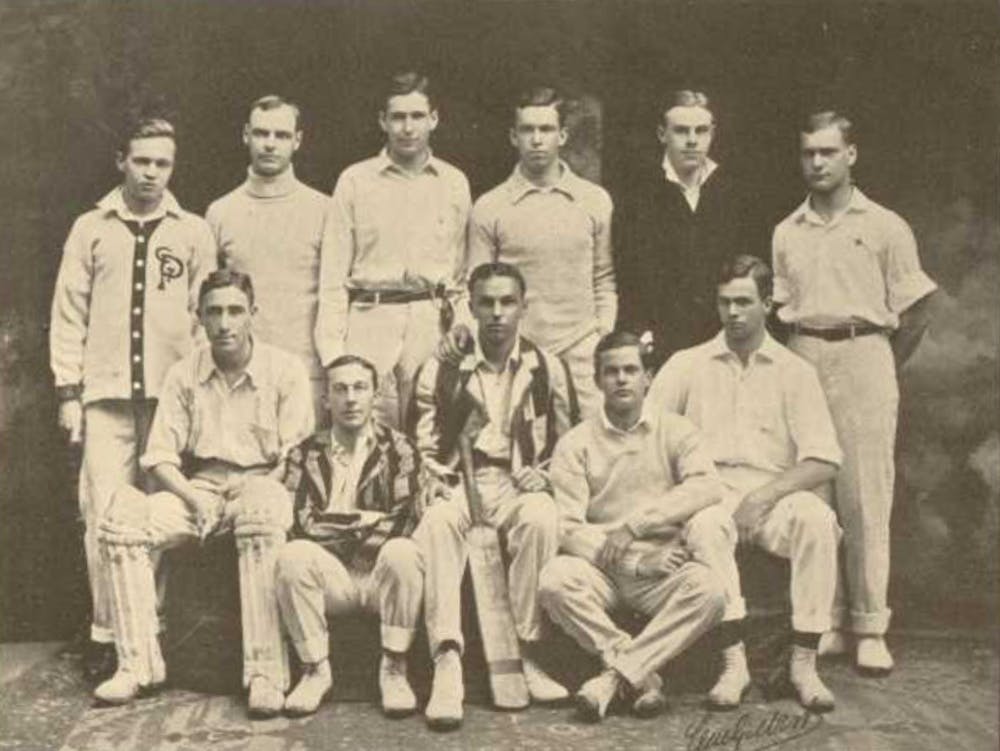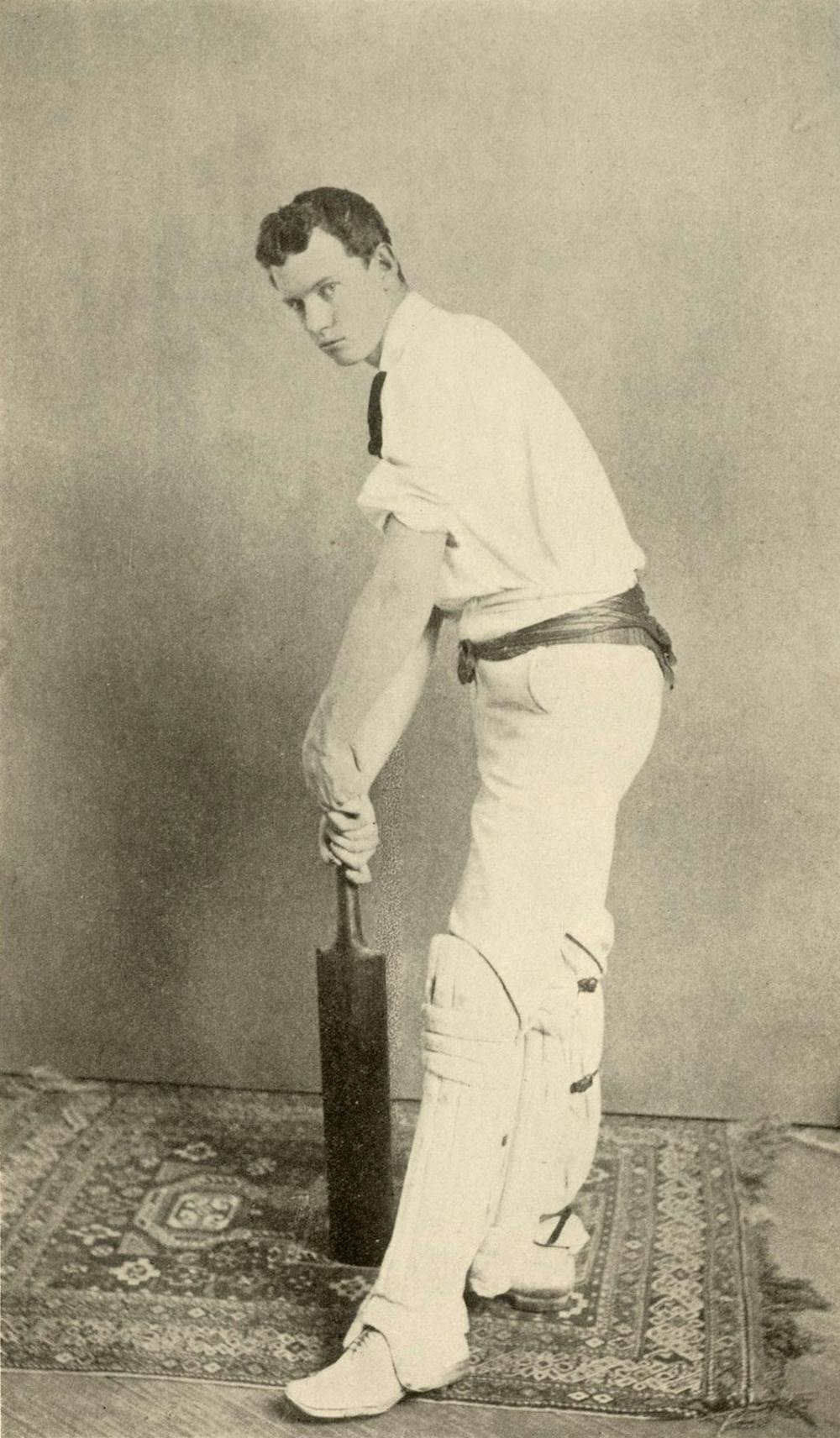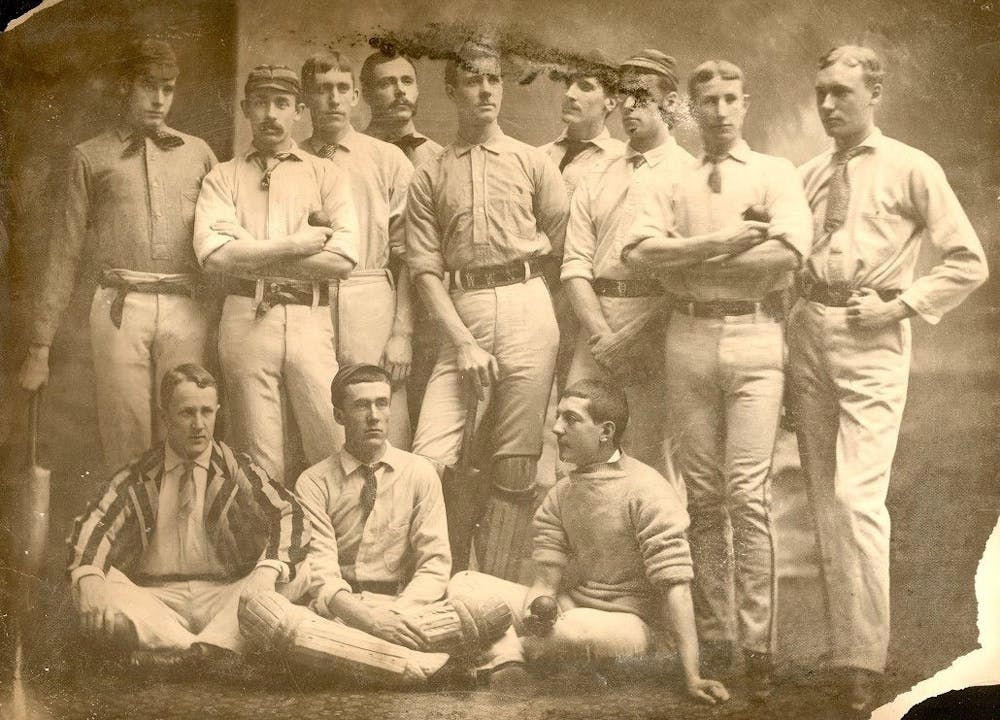
(Photo from The Record)
Before football even had an established set of rules, the Quakers were playing a different game: cricket.
Cricket was the first organized sport to be offered by Penn. In 1842, a student named William Rotch Wister brought the European game to campus when he founded the Junior Cricket Club, one the first cricket clubs in the United States to be made up of Americans.
In cricket, two teams of 11 face off on an elliptically-shaped field that can be anywhere from 100 to 160 yards across. A bowler throws a cricket ball overhand from the pitch area while their teammates defend. The opposing team attempts to hit the ball and run along the wickets to the other end of the field.
While the rules seem similar to baseball, the British and American national pastimes are vastly different. A cricket game can last for days, and it is possible for batters to score 400 runs in one at bat.
Penn’s Junior Club rented a cricket field in Camden, N.J. one day per week. Coaches were not a common feature of collegiate teams in this era, but the Junior Club hired an Englishman, William Bradshaw, for technique instruction.
During the mid-1840s, the Junior Club boasted over 50 students, including Benjamin Franklin’s great-great-grandson, Thomas Hewson Bache. The program was large enough for the men to split into two teams and scrimmage with one another. Penn also often played matches against the Germantown Boys Club.
However, when Wister graduated in 1846, the Junior Club lost its founder and its direction. Disputes over leadership and funding led the club to completely disband that year.
Wister, whose devotion to the sport earned him the honorary title of “Father of American Cricket,” would go on to found the Philadelphia and Germantown Cricket Clubs, both of which still exist today. The Philadelphia Cricket Club is the oldest country club in the United States.
Cricket wouldn’t make a resurgence on campus for almost two decades. On May 7, 1864, Penn and Haverford met on the cricket field, marking the Quakers’ first-ever intercollegiate athletics competition and the third intercollegiate athletics event in the nation. Penn lost the match by a score of 89-60.
While the Quakers did not play any intercollegiate matches in 1865, cricket was officially back on campus, with the budding program captained by Philadelphia cricket legend Horace Magee.
After Magee graduated, he joined both the Philadelphia and Germantown Cricket Clubs that had been founded by Wister. In 1874, Magee was selected to play on the Philadelphia 12 in the first-ever Halifax Cup, a professional cricket tournament held annually in Philadelphia with teams from the United States, Canada, and England.
Penn’s rivalry with Haverford was sparked again in 1866, and the two schools continued to regularly face off on the cricket field.
Penn’s Athletic Association was formed in 1877, and cricket’s popularity continued to grow, with undergraduate classes and professional schools forming their own teams alongside the varsity program.
In 1881, Penn formed the Intercollegiate Cricket Association together with Haverford, Harvard, Princeton, and Columbia. Penn dominated the early years, winning the title in 1882 and 1883. While Haverford took back the crown in 1884, the Quakers followed up with an eight-season tear, winning every year between 1885 and 1892.
Penn was so dominant in those years that the Red and Blue, bored with the lack of quality competition, almost left the ICA.
“For the past few years the contest with Haverford has been almost the only one in the league,” the DP wrote on Jan. 3, 1888. “And, though it was not entirely a one-sided struggle, still Pennsylvania’s easy superiority has rather diminished her interest, and the dissolution of the league has been seriously considered.”

(Photo from The Record)
With such local success, Penn’s cricket program turned towards international competition in 1895. That July, six Quakers joined forces with other American college cricketers to host a team made up of Canadian university students in Germantown.
When Franklin Field opened that year, along with its track, field house, and tennis courts, the stadium housed a cricket crease.
In September 1895, Penn’s varsity team and alumni took on current and past members of the Oxford and Cambridge teams. The Quakers handily beat the English cricketers by 100 runs.
“Although the graduates predominated so largely, the team was a truly representative one and showed the visitors from the English Universities that we can play their own game,” the DP wrote on Sept. 30, 1895. “The match was characterized by the utmost good feeling, and is a significant proof that international contests can be conducted in a fair and sportsmanlike manner.”
Although they often struggled to field a large team at the beginning of each season, the program survived, and the Quakers even continued to regularly face Canadian cricket teams. In 1906, Penn toured Toronto to compete with local cricketers, including a team from University of Toronto. The trip up north was so successful that the cricket club planned a European trip for the following year.
In June of 1907, the Red and Blue cricket team crossed the Atlantic on a steamship, a nine-day journey, and spent nearly two months playing against teams in England and Ireland. Fourteen men were selected for the tour, and in honor of their achievement overseas, each of them was awarded a Varsity “P” upon their return.
Penn cricket was represented in England again in the summer of 1908. Two members of the varsity 11, Herbert Hordern and Charles Winters, were selected for the professional Gentlemen of Philadelphia Cricket Team to make the trip overseas.
Hordern, who captained Penn’s team in 1909, also traveled to Jamaica with the Gentlemen of Philadelphia, taking 52 wickets for an average of 6.96 runs per wicket through five games.
In the 1909 season, Penn had enough interest at tryouts with 54 candidates to field a freshman team and three varsity teams. The best 12 Quakers returned to tour Canada that June. Penn defeated McGill by a score of 131-77 and was also victorious against the Toronto Cricket Club, the University of Toronto, and the Hamilton Cricket Club, but a match with Ottawa ended in a draw.
In 1912, instead of the Canadian trip that had become customary for Penn cricketers each June, arrangements were made for the Quakers to tour Bermuda. The Red and Blue dropped all three matches to the local squads, although they lost their final game against the All-Bermuda team by a margin of six runs.
The cricket program began to falter as the United States and Penn students became involved in World War I. With most of the starting 11 gone from campus due to enlistments in May 1917, the Quakers called off the remainder of the cricket season. This move signified the beginning of the end for the varsity program.
The team wouldn’t officially return until 1919, but with a lack of facilities on campus, the Quakers were forced to share a practice field with Haverford, their old rivals. It looked like the program might be back on the upswing in 1920, when the Red and Blue secured a coach in former professional player Edgar Gest and arranged a return trip to Canada.
“During the tour they met the most experienced and best balanced teams in eastern Canada, and impressed all who saw them play with their sportsmanship and fighting spirit,” the DP wrote on Sept. 28, 1920. “As the tour came to a close the fielding of the team showed a marked improvement.”
Within four years, however, the historic program would be little more than a memory. In March 1924, professional cricketers were banned from intercollegiate clubs, and with dwindling interest, within two months cricket was dropped entirely by Penn’s Athletics Council. By the end of the year, the Intercollegiate Cricket Association folded.

A cricket team of both undergrad and graduate students did crop up in 1954 to take on Haverford, in celebration of the 90th anniversary of the historic 1864 match, but cricket never again received varsity designation on campus.
Today, Haverford has the only varsity cricket team in the nation. Penn cricket still exists as well, although under the banner of a club team.
Despite the difference in their status, the Haverford and Penn rivalry lives on. In the 156 years since their first meeting in 1864, the two cricket teams have faced each other 55 times, with their most recent matchup taking place on Sept. 15, 2019.
Cricket, the oldest athletic tradition on Penn’s campus, is little-known, but still alive and well.
The Daily Pennsylvanian is an independent, student-run newspaper. Please consider making a donation to support the coverage that shapes the University. Your generosity ensures a future of strong journalism at Penn.
Donate







